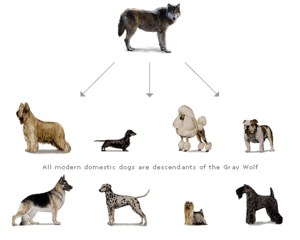Evolution of Dog Breeds: Difference between revisions
No edit summary |
No edit summary |
||
| (One intermediate revision by the same user not shown) | |||
| Line 14: | Line 14: | ||
==Conclusion== | ==Conclusion== | ||
[[Image: Evolution-of-man-and-dog.jpg|thumb|400px|right|Man evolves with dog. https://beautifullybony.wordpress.com/archive/bone-of-the-month/the-domestic-dog/using-genomes-to-find-the-origins-of-domestic-dogs/]]While not every aspect of the evolution of dog breeds was discussed on this page (as the evolution of dog breeds has bounds of information, perspectives, and research), hopefully the general idea of wolf to dog has been explained. While dogs have been proven to be descendants of the gray wolf, it is still a bit controversial on when and more importantly, where, the first domesticated dog was created. DNA sequencing and mapping has shown southern China, Europe, and Mongolia as possible origins of the domestic dog. Perhaps the wolf became domesticated in multiple locations around the same time, and therefore there are multiple origins. No matter where or when they originated, the dog will always remain one of man’s best friends. As one anthropologist puts it, “The domestication of dogs was one of the most extraordinary events in human history.” <ref>[https://www.smithsonianmag.com/science-nature/how-wolves-really-became-dogs-180970014/ Handwerk, B. "When and How Did Wolves Become Dogs" 2018.]</ref> | [[Image: Evolution-of-man-and-dog.jpg|thumb|400px|right|Man evolves with dog. (Not scientifically accurate, but has the general idea) https://beautifullybony.wordpress.com/archive/bone-of-the-month/the-domestic-dog/using-genomes-to-find-the-origins-of-domestic-dogs/]]While not every aspect of the evolution of dog breeds was discussed on this page (as the evolution of dog breeds has bounds of information, perspectives, and research), hopefully the general idea of wolf to dog has been explained. While dogs have been proven to be descendants of the gray wolf, it is still a bit controversial on when and more importantly, where, the first domesticated dog was created. DNA sequencing and mapping has shown southern China, Europe, and Mongolia as possible origins of the domestic dog. Perhaps the wolf became domesticated in multiple locations around the same time, and therefore there are multiple origins. No matter where or when they originated, the dog will always remain one of man’s best friends. As one anthropologist puts it, “The domestication of dogs was one of the most extraordinary events in human history.” <ref>[https://www.smithsonianmag.com/science-nature/how-wolves-really-became-dogs-180970014/ Handwerk, B. "When and How Did Wolves Become Dogs" 2018.]</ref> | ||
<br> While the first domestic dog had wolf-like appearance, the current 340+ dog breeds are representative of phenotypic diversity. There are purebred breeds, which are typically bred for their pedigree and for showing (in dog shows such as The National Dog Show run by the Kennel Club of Philadelphia or the Westminster Dog Show run by Westminster Kennel Club). There are also mutt dogs, which occur from random mating of often abandoned or stray dogs. Most of these rescue dogs are in need of loving homes, as they are typically sent to puppy mills or are left to die. Rescuing dogs slows down the breeding of dogs just for their pedigree. Irresponsible breeders are cause for concern because of the extensive amounts of dogs that they produce, without taking the time to care about the dogs’ wellbeings. <br><br> | <br> While the first domestic dog had wolf-like appearance, the current 340+ dog breeds are representative of phenotypic diversity. There are purebred breeds, which are typically bred for their pedigree and for showing (in dog shows such as The National Dog Show run by the Kennel Club of Philadelphia or the Westminster Dog Show run by Westminster Kennel Club) <ref>[https://nds.nationaldogshow.com/ Kennel Club of Philadelphia</ref> <ref>[https://www.westminsterkennelclub.org/ Westminster Kennel Club (NY)</REF>. There are also mutt dogs, which occur from random mating of often abandoned or stray dogs. Most of these rescue dogs are in need of loving homes, as they are typically sent to puppy mills or are left to die. Rescuing dogs slows down the breeding of dogs just for their pedigree. Irresponsible breeders are cause for concern because of the extensive amounts of dogs that they produce, without taking the time to care about the dogs’ wellbeings. <br><br> | ||
The purebred lines were created via selection of desirable characteristics (such as physical appearance or intelligence, etc.) Purebreds have a set standard of traits that produce the “best in show” or the ultimate dog of its breed. Purebreds also typically have a predictable temperament, which is desirable when adopting a life-long friend. No matter how you choose to bring a dog into your family, whether it be rescuing through a shelter or purchasing through a breeder, it is important to know that your dog came to be through the process of evolution and artificial selection. | The purebred lines were created via selection of desirable characteristics (such as physical appearance or intelligence, etc.) Purebreds have a set standard of traits that produce the “best in show” or the ultimate dog of its breed. Purebreds also typically have a predictable temperament, which is desirable when adopting a life-long friend. No matter how you choose to bring a dog into your family, whether it be rescuing through a shelter or purchasing through a breeder, it is important to know that your dog came to be through the process of evolution and artificial selection. | ||
Latest revision as of 13:24, 6 December 2019
This is a page by TILLIE WANG.
Introduction

The evolution of dog breeds is an interesting story of human involvement in the domestication of a wild animal, the gray wolf. The domestic dog is called Canis familiaris. The artificial selection of dog breeds has led to diversity in size, conformation, and pelage seen today in domestic canines [1]. The dog evolved approximately 12,000-15,000 years ago when early humans domesticated animals and plants for farming during the Stone Age.
There are different views on how dogs evolved- was their evolution due to humans selecting animals for domestication, or was it that the animals had to evolve because they were in a new ecological niche (co-existing with humans in a domestic setting)? [2] Through phylogenetic analysis of dog and gray wolf mitochondrial DNA (mtDNA) sequences, it was found that domestic dog sequences are found in at least four distinct clades, implying a single origination event and at least three other origination or interbreeding events [3]. Further studies have concluded that domestic dogs originated in Siberia and migrated into the Americas, Asia, and the rest of Europe [4].
From the evolution of the domestic dog, there is the evolution of the modern dog breeds. The American Kennel Club (AKC) recognizes 193 of the 340+ dog breeds in the world [5]. Many dogs are bred for specific tasks or characteristics/traits. For example, there are hunting/game dogs, guard dogs, herding dogs, and companion dogs. The AKC has lists on standards for ideal pure-bred traits ranging from temperament to physical appearance to movement and gait. With human evolution and sophistication came breeding sophistication and evolution. Dogs were bred and selected for "desirable traits" leading to the modern dog breeds of today [6].
Physical Evolution
Current research in the physical evolution of dogs includes insight that the evolution of facial features of domestic dogs, more specifically "puppy dog eyes", has occurred within the past couple centuries to better communicate with humans. The research found that dogs have evolved new muscles around the eye that can raise their eyebrows.

Dogs specifically have evolved to raise their inner eyebrows. The scientists and psychologists on the research team believe that by raising their eyebrows, dogs are making their eyes appear larger and more infant like [7].
Behaviorists, anatomists, and comparative psychologists found that the dogs raised their inner eyebrow more and at higher intensity than wolves when exposed to a human for 2 minutes. Furthermore, the research found that "puppy dog eyes" could be the result of unconscious decisions when breeding dogs. In other words, the ability to raise the inner eyebrow was a desirable trait when breeding dogs, and therefore the evolution is supplemented by the result of selection [8]. Dogs could have also evolved because of their increase in human contact and need to mimic human facial expressions.
The evolution of certain dogs' physical appearance is due to selective breeding where the desirable appearance is bred with another dog of the same appearance to create offspring with that same desirable feature. Continuous lines of breeding lead to pure-bred lineage, much like bloodlines in royal families.
Genetics

Genetic analysis and research has found that because of domestication there came to be a relaxation of typical selective forces of natural selection (survival of the fittest). Rather, dogs were selected for traits that, in the wild, would make them less fit for survival. Modern domestic dogs also have greater variability in their genomes than in their ancestral counterparts. Interestingly, genetic variation within the Canis familiaris (dog family has different breeds with a wide range of phenotypes) is greater than variation between different species in the entire family of Canidaes [9]. A phylogenetic analysis of 736 base pairs (bp) of the cytochrome b gene showed that gray wolves are the only direct ancestor to the domestic dog with dog-wolf sequences differing in only about 0-12 substitutions [10].
Interestingly, the most popular dog breeds in America are of European descent. For example, the Labrador Retriever, the German Shepard, and the Beagle, are all of European descent. Scientists at the National Institutes of Health (NIH) have sequenced 150+ dog breed genomes to map the origins and migration of man's best friend. They found that, unsurprisingly, Golden Retrievers and Irish Setters can be traced back to Victorian England, where they were used as hunting dogs when the gun was widely used for game hunting expeditions. The Golden Retriever and Irish Setter are closely linked with Spaniels on the phylogenetic tree. Furthermore, the researchers at the NIH have looked for "New World Dog" genomes in Central and South American dogs and found that they are descended from the dogs that crossed the Bering Strait with ancestors of Native Americans [11].
Microbiome

A recent study found that dog microbiome is the most similar to the human microbiome (compared to mice and pigs). The dog gut microbiome has 1,247,405 genes, whereas humans have about 3.3 million genes in their gut microbiomes [12] [13]. Although the microbiomes very in number of genes, the similarities of the genes are seen when the effects of changes in a dog's diet can predict the outcome of a change in a human's diet. This research is revolutionary in the study of the human digestive and intestinal tracts and their implications on human health. It is known that pigs have a structurally similar digestive system to humans, and they have been used as model systems for nutritional studies. However, with this new knowledge, scientists can now study changes in diet (such as high-protein or low-carbohydrate) in dogs and link the results with those of humans.
Other studies have found that dogs and humans that live in the same house share their microbiomes, particularly, the skin microbiota. Another study found that people who lived with dogs had greater similarities in their nasal and skin microbiomes compared to people who did not live with dogs, suggesting the influence of pets on promoting microbial exchange [14]. The benefits of having pets in the house have even been covered by The New York Times in an article entitled "Are Pets the New Probiotic?" [15].
Conclusion

While not every aspect of the evolution of dog breeds was discussed on this page (as the evolution of dog breeds has bounds of information, perspectives, and research), hopefully the general idea of wolf to dog has been explained. While dogs have been proven to be descendants of the gray wolf, it is still a bit controversial on when and more importantly, where, the first domesticated dog was created. DNA sequencing and mapping has shown southern China, Europe, and Mongolia as possible origins of the domestic dog. Perhaps the wolf became domesticated in multiple locations around the same time, and therefore there are multiple origins. No matter where or when they originated, the dog will always remain one of man’s best friends. As one anthropologist puts it, “The domestication of dogs was one of the most extraordinary events in human history.” [16]
While the first domestic dog had wolf-like appearance, the current 340+ dog breeds are representative of phenotypic diversity. There are purebred breeds, which are typically bred for their pedigree and for showing (in dog shows such as The National Dog Show run by the Kennel Club of Philadelphia or the Westminster Dog Show run by Westminster Kennel Club) [17] [18]. There are also mutt dogs, which occur from random mating of often abandoned or stray dogs. Most of these rescue dogs are in need of loving homes, as they are typically sent to puppy mills or are left to die. Rescuing dogs slows down the breeding of dogs just for their pedigree. Irresponsible breeders are cause for concern because of the extensive amounts of dogs that they produce, without taking the time to care about the dogs’ wellbeings.
The purebred lines were created via selection of desirable characteristics (such as physical appearance or intelligence, etc.) Purebreds have a set standard of traits that produce the “best in show” or the ultimate dog of its breed. Purebreds also typically have a predictable temperament, which is desirable when adopting a life-long friend. No matter how you choose to bring a dog into your family, whether it be rescuing through a shelter or purchasing through a breeder, it is important to know that your dog came to be through the process of evolution and artificial selection.
References
- ↑ Vilá, C. et al."Phylogenetic relationships, evolution, and genetic diversity of the domestic dog." 1999.
- ↑ Morey, D. "The Early Evolution of the Domestic Dog." 1994.
- ↑ Ostrander et al. "The Canine Genome." 2005.
- ↑ Leathlobhair et al. "The Evolutionary History of Dogs in the Americas." 2014.
- ↑ "Dog Breeds." 2019.
- ↑ "Dog Breeds." 2019.
- ↑ Kaminski et al. "The Evolution of Puppy Dog Eyes." 2019.
- ↑ Kaminski et al. "The Evolution of Puppy Dog Eyes." 2019.
- ↑ Adams, J. "Gemetics of Dog Breeding." 2008.
- ↑ Vilá, C. et al."Phylogenetic relationships, evolution, and genetic diversity of the domestic dog." 1999.
- ↑ Parker, H. et al."The Evolution of Dog Breeds Now Mapped." 2017.
- ↑ Coelho, L. et al."Similarity of the dog and human gut microbiomes in gene content and response to diet." 2018.
- ↑ Zhu, B. et al."Human gut microbiome: the second genome of human body." 2010.
- ↑ Trinh, P. et al."One Health Relationships Between Human, Animal, and Environmental Microbiomes: A Mini-Review." 2018.
- ↑ Schiffman, R. "Are Pets the New Probiotic?" 2017.
- ↑ Handwerk, B. "When and How Did Wolves Become Dogs" 2018.
- ↑ [https://nds.nationaldogshow.com/ Kennel Club of Philadelphia
- ↑ [https://www.westminsterkennelclub.org/ Westminster Kennel Club (NY)
Edited by Tillie Wang, student of Joan Slonczewski for BIOL 116 Information in Living Systems, 2019, Kenyon College.
